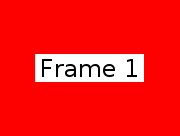With 5 images I have to create a video of 60 seconds in ffmpeg, each image has to display for 15 seconds. after 15 seconds, first image has to fade out and 2nd image has to fade in, after that 2nd image has to fade out, 3rd image has to fade in..etc. Please guide me how can I achieve this using ffmpeg commands.
Answer
Scroll down for crossfade method.

Example where each image displayed for 5 seconds and each has a fade that lasts 1 second. Each image input has the same width, height, and sample aspect ratio. If they vary in size see example #3 below.
MP4 output
ffmpeg \
-loop 1 -t 5 -i input0.png \
-loop 1 -t 5 -i input1.png \
-loop 1 -t 5 -i input2.png \
-loop 1 -t 5 -i input3.png \
-loop 1 -t 5 -i input4.png \
-filter_complex \
"[0:v]fade=t=out:st=4:d=1[v0]; \
[1:v]fade=t=in:st=0:d=1,fade=t=out:st=4:d=1[v1]; \
[2:v]fade=t=in:st=0:d=1,fade=t=out:st=4:d=1[v2]; \
[3:v]fade=t=in:st=0:d=1,fade=t=out:st=4:d=1[v3]; \
[4:v]fade=t=in:st=0:d=1,fade=t=out:st=4:d=1[v4]; \
[v0][v1][v2][v3][v4]concat=n=5:v=1:a=0,format=yuv420p[v]" -map "[v]" out.mp4
With audio
Same as above but with audio:
ffmpeg \
-loop 1 -t 5 -i input0.png \
-loop 1 -t 5 -i input1.png \
-loop 1 -t 5 -i input2.png \
-loop 1 -t 5 -i input3.png \
-loop 1 -t 5 -i input4.png \
-i audio.m4a \
-filter_complex \
"[0:v]fade=t=out:st=4:d=1[v0]; \
[1:v]fade=t=in:st=0:d=1,fade=t=out:st=4:d=1[v1]; \
[2:v]fade=t=in:st=0:d=1,fade=t=out:st=4:d=1[v2]; \
[3:v]fade=t=in:st=0:d=1,fade=t=out:st=4:d=1[v3]; \
[4:v]fade=t=in:st=0:d=1,fade=t=out:st=4:d=1[v4]; \
[v0][v1][v2][v3][v4]concat=n=5:v=1:a=0,format=yuv420p[v]" -map "[v]" -map 5:a -shortest out.mp4
For input images with varying or arbitrary sizes
Like the first example, but with input images that vary in width x height. They will be padded to fit within a 1280x720 box:
ffmpeg \
-loop 1 -t 5 -i input0.png \
-loop 1 -t 5 -i input1.png \
-loop 1 -t 5 -i input2.png \
-loop 1 -t 5 -i input3.png \
-loop 1 -t 5 -i input4.png \
-filter_complex \
"[0:v]scale=1280:720:force_original_aspect_ratio=decrease,pad=1280:720:(ow-iw)/2:(oh-ih)/2,setsar=1,fade=t=out:st=4:d=1[v0]; \
[1:v]scale=1280:720:force_original_aspect_ratio=decrease,pad=1280:720:(ow-iw)/2:(oh-ih)/2,setsar=1,fade=t=in:st=0:d=1,fade=t=out:st=4:d=1[v1]; \
[2:v]scale=1280:720:force_original_aspect_ratio=decrease,pad=1280:720:(ow-iw)/2:(oh-ih)/2,setsar=1,fade=t=in:st=0:d=1,fade=t=out:st=4:d=1[v2]; \
[3:v]scale=1280:720:force_original_aspect_ratio=decrease,pad=1280:720:(ow-iw)/2:(oh-ih)/2,setsar=1,fade=t=in:st=0:d=1,fade=t=out:st=4:d=1[v3]; \
[4:v]scale=1280:720:force_original_aspect_ratio=decrease,pad=1280:720:(ow-iw)/2:(oh-ih)/2,setsar=1,fade=t=in:st=0:d=1,fade=t=out:st=4:d=1[v4]; \
[v0][v1][v2][v3][v4]concat=n=5:v=1:a=0,format=yuv420p[v]" -map "[v]" out.mp4
See the examples in Resizing videos to fit into static sized player if you want to crop (fill the screen) instead of pad (letterbox/pillarbox), or if you want to prevent upscaling.
GIF output
Adds the filters from How do I convert a video to GIF using ffmpeg, with reasonable quality?
ffmpeg \
-framerate 10 -loop 1 -t 5 -i input0.png \
-framerate 10 -loop 1 -t 5 -i input1.png \
-framerate 10 -loop 1 -t 5 -i input2.png \
-framerate 10 -loop 1 -t 5 -i input3.png \
-framerate 10 -loop 1 -t 5 -i input4.png \
-filter_complex \
"[0:v]fade=t=out:st=4:d=1[v0]; \
[1:v]fade=t=in:st=0:d=1,fade=t=out:st=4:d=1[v1]; \
[2:v]fade=t=in:st=0:d=1,fade=t=out:st=4:d=1[v2]; \
[3:v]fade=t=in:st=0:d=1,fade=t=out:st=4:d=1[v3]; \
[4:v]fade=t=in:st=0:d=1,fade=t=out:st=4:d=1[v4]; \
[v0][v1][v2][v3][v4]concat=n=5:v=1:a=0,split[v0][v1]; \
[v0]palettegen[p];[v1][p]paletteuse[v]" -map "[v]" out.gif
Use the -loop output option to control the number of times the GIF loops. Default is infinite loop if this option is not used. A value of -1 is no loop.
Options and filters used:
-tto set duration in seconds of each input.-loop 1loops the image otherwise it would have a duration of 1 frame.-framerateto set input image frame rate (default when undeclared is 25). Useful for making GIF.scale with pad to fit the input images into a specific, uniform size (used in example #3).
fade to fade in and out.
dis the duration of the fade.stis when it starts.concat to concatenate (or "join") each image.
format to output a chroma subsampling scheme that is compatible with non-FFmpeg based players if outputting MP4 and encoding with libx264 (the default encoder for MP4 output if it is supported by your build).
split to make copies of a filter output. Needed by the palette* filters to do everything in one command.
palettegen and paletteuse for making nice looking GIF.
Example where each image displayed for 5 seconds and each has a crossfade that lasts 1 second. Each image input has the same width, height, and sample aspect ratio. If they vary in size then adapt example #3 above.
MP4 output
ffmpeg \
-loop 1 -t 5 -i 1.png \
-loop 1 -t 5 -i 2.png \
-loop 1 -t 5 -i 3.png \
-loop 1 -t 5 -i 4.png \
-loop 1 -t 5 -i 5.png \
-filter_complex \
"[1]format=yuva444p,fade=d=1:t=in:alpha=1,setpts=PTS-STARTPTS+4/TB[f0]; \
[2]format=yuva444p,fade=d=1:t=in:alpha=1,setpts=PTS-STARTPTS+8/TB[f1]; \
[3]format=yuva444p,fade=d=1:t=in:alpha=1,setpts=PTS-STARTPTS+12/TB[f2]; \
[4]format=yuva444p,fade=d=1:t=in:alpha=1,setpts=PTS-STARTPTS+16/TB[f3]; \
[0][f0]overlay[bg1];[bg1][f1]overlay[bg2];[bg2][f2]overlay[bg3]; \
[bg3][f3]overlay,format=yuv420p[v]" -map "[v]" -movflags +faststart out.mp4
With audio
ffmpeg \
-loop 1 -t 5 -i 1.png \
-loop 1 -t 5 -i 2.png \
-loop 1 -t 5 -i 3.png \
-loop 1 -t 5 -i 4.png \
-loop 1 -t 5 -i 5.png \
-i music.mp3 \
-filter_complex \
"[1]format=yuva444p,fade=d=1:t=in:alpha=1,setpts=PTS-STARTPTS+4/TB[f0]; \
[2]format=yuva444p,fade=d=1:t=in:alpha=1,setpts=PTS-STARTPTS+8/TB[f1]; \
[3]format=yuva444p,fade=d=1:t=in:alpha=1,setpts=PTS-STARTPTS+12/TB[f2]; \
[4]format=yuva444p,fade=d=1:t=in:alpha=1,setpts=PTS-STARTPTS+16/TB[f3]; \
[0][f0]overlay[bg1];[bg1][f1]overlay[bg2];[bg2][f2]overlay[bg3]; \
[bg3][f3]overlay,format=yuv420p[v]" -map "[v]" -map 5:a -shortest -movflags +faststart out.mp4
Crossfade between two videos with audio
Select 5 second segment from each input and add a 1 second crossfade:
ffmpeg -i input0.mp4 -i input1.mp4 -filter_complex \
"[0:v]trim=start=5:end=10,setpts=PTS-STARTPTS[v0];
[1:v]trim=start=12:end=17,setpts=PTS-STARTPTS+4/TB,format=yuva444p,fade=st=4:d=1:t=in:alpha=1[v1];
[v0][v1]overlay,format=yuv420p[v];
[0:a]atrim=start=5:end=10,asetpts=PTS-STARTPTS[a0];
[1:a]atrim=start=12:end=17,asetpts=PTS-STARTPTS[a1];
[a0][a1]acrossfade=d=1[a]" \
-map "[v]" -map "[a]" output.mp4
GIF output
ffmpeg \
-framerate 10 -loop 1 -t 5 -i 1.png \
-framerate 10 -loop 1 -t 5 -i 2.png \
-framerate 10 -loop 1 -t 5 -i 3.png \
-framerate 10 -loop 1 -t 5 -i 4.png \
-framerate 10 -loop 1 -t 5 -i 5.png \
-filter_complex \
"[1]format=rgba,fade=d=1:t=in:alpha=1,setpts=PTS-STARTPTS+4/TB[f0]; \
[2]format=rgba,fade=d=1:t=in:alpha=1,setpts=PTS-STARTPTS+8/TB[f1]; \
[3]format=rgba,fade=d=1:t=in:alpha=1,setpts=PTS-STARTPTS+12/TB[f2]; \
[4]format=rgba,fade=d=1:t=in:alpha=1,setpts=PTS-STARTPTS+16/TB[f3]; \
[0][f0]overlay[bg1];[bg1][f1]overlay[bg2];[bg2][f2]overlay[bg3];[bg3][f3]overlay,split[v0][v1]; \
[v0]palettegen[p];[v1][p]paletteuse[v]" -map "[v]" out.gif
Use the -loop output option to control the number of times the GIF loops. Default is infinite loop if this option is not used. A value of -1 is no loop.

No comments:
Post a Comment